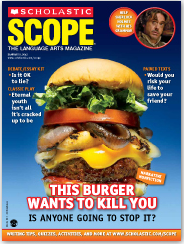 By visiting Scholastic Scope online, viewers have access to tons of free resources, including PDF files of stories and readers' theater pieces, vocabulary and grammar worksheets, ACT-style quizzes, essay writing prompts, and much much more! I'm truly amazed that there is no log-in required to view these materials. There is even information regarding how the materials align with the Common Core State Standards. According to the website, these materials will be password-protected in the future, so visit their website and save these files while it's free! I plan on using many of the resources (my school has a subscription, so I will be able to access information even after it is password-protected); I'm particularly interested in the readers' theater pieces because they are a great way to expand students' background knowledge regarding literary masterpieces.
2 Comments
 Recently, a former student of mine sent me a link to a hilarious post on the blog Hyperbole and a Half, where the author talks about the irritation grammar sticklers feel when they see the phrase "a lot" incorrectly written as one word: "alot." In order to cope with other people's grammar, the blogger has created a fictional creature called the alot (see left--yup, that's an alot). Anyway, this is a fun way to teach your students about the difference between alot (wrong) and a lot (right). Below, I'm attaching files. One file is the blog post with the "alot of beer cans" removed for school-appropriateness reasons. The second file is a linemaster of the alot so your students can design their own creatures. I'm having students make alots for homework passes, and then I'm going to display them on my classroom bulletin board. (I'll be sure to post pictures asap.) UPDATE: Alots created by my students can be viewed HERE. Note: According to the FAQ page on Hyperbole and a Half, the writer does not mind her work being used for educational purposes, but please give credit where credit is due. Don't pretend that you are the wise elder who in fact created the alot.
 Online Magnetic Poetry: http://play.magpogames.com/ Everyone has seen--and maybe even played with--the tin can of magnetic words that you can arrange to make poetry. Recently, my sister gave me her Office Magnetic Poetry and, after removing any words that could be put into compromising situations, I threw the words on my dry-erase board and waited. Now, my magnetic poetry seems to have a group of devoted followers who enjoy coming in at the beginning of the hour to arrange the magnets and have their words represented throughout the day. On a hunch, I searched for an online version and found that the makers of Magnetic Poetry will let you try before you buy on their website. You can also view submitted poems created by others. What a fun end-of-the-hour activity! Or an interactive writing prompt! Or a fun National Poetry Month activity! This would work really well with a Smart Board.  Quick and Dirty Tips offers some wonderful podcasts by experts. I have used Grammar Girl and The Public Speaker in my classroom as bellringer activities by writing my own questions and having students write their responses on note cards. Podcasts can be downloaded as an mp3, streamed from the website, or printed as a transcript. Most of the podcasts are broken down by subject area; for example, Grammar Girl's podcasts are organized into categories including punctuation, usage, and style. Other experts that look promising include the Math Dude and the Nutrition Diva.  PicLits calls itself "Inspired Picture Writing." I like it because it's great for visual learners, and it combined writing with grammar. Students can select from a wide collection of photos, and then drag-and-drop words from grammatical categories (nouns, verbs, adjectives and adverbs) to create sentences, poems, or to brainstorm words and phrases for a longer composition. I spent one whole day during the summer creating my own PicLits as story starters for descriptive writing practice. I dragged words from the adjective and adverbs columns (making sure that each picture contained a few words that I thought my freshmen would not be familiar with) and then I had students write descriptions of the photos using the descriptive words on their PicLit. It went so well that I laminated them for reuse. I was amazed at the compositions that developed out of this exercise and, while the words weren't completely of their own selection, most students eagerly turned to a dictionary in order to find the meaning and were able to use the words appropriately. I also have students return to this previous writing at times, when they feel uninspired by the descriptive writing muse. |
AuthorDr. Jessica Pilgreen, Ed.D. Archives
December 2020
Categories
All
|
||||||||||||





